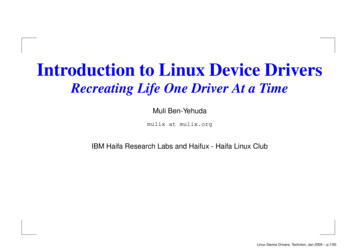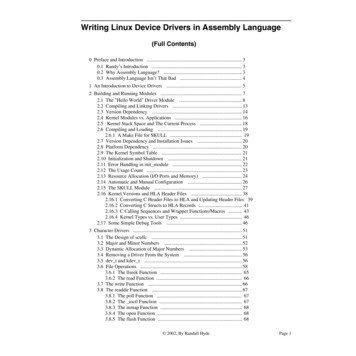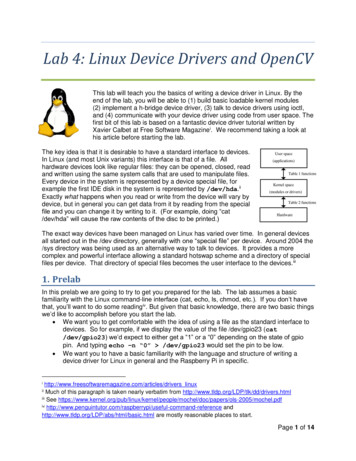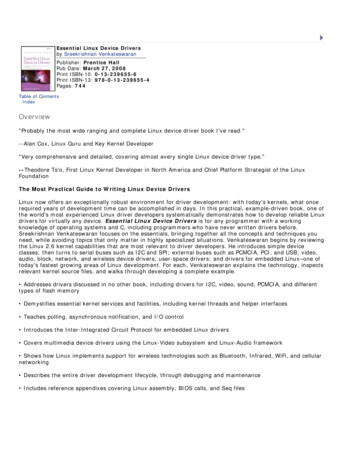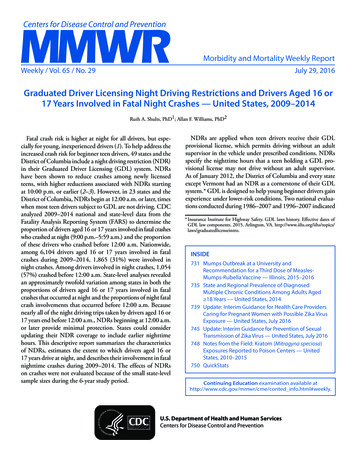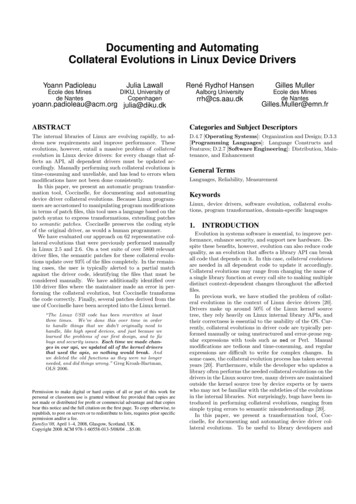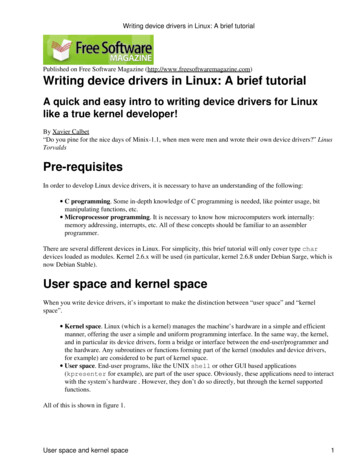
Transcription
Writing device drivers in Linux: A brief tutorialPublished on Free Software Magazine (http://www.freesoftwaremagazine.com)Writing device drivers in Linux: A brief tutorialA quick and easy intro to writing device drivers for Linuxlike a true kernel developer!By Xavier Calbet“Do you pine for the nice days of Minix-1.1, when men were men and wrote their own device drivers?” LinusTorvaldsPre-requisitesIn order to develop Linux device drivers, it is necessary to have an understanding of the following: C programming. Some in-depth knowledge of C programming is needed, like pointer usage, bitmanipulating functions, etc. Microprocessor programming. It is necessary to know how microcomputers work internally:memory addressing, interrupts, etc. All of these concepts should be familiar to an assemblerprogrammer.There are several different devices in Linux. For simplicity, this brief tutorial will only cover type chardevices loaded as modules. Kernel 2.6.x will be used (in particular, kernel 2.6.8 under Debian Sarge, which isnow Debian Stable).User space and kernel spaceWhen you write device drivers, it’s important to make the distinction between “user space” and “kernelspace”. Kernel space. Linux (which is a kernel) manages the machine’s hardware in a simple and efficientmanner, offering the user a simple and uniform programming interface. In the same way, the kernel,and in particular its device drivers, form a bridge or interface between the end-user/programmer andthe hardware. Any subroutines or functions forming part of the kernel (modules and device drivers,for example) are considered to be part of kernel space. User space. End-user programs, like the UNIX shell or other GUI based applications(kpresenter for example), are part of the user space. Obviously, these applications need to interactwith the system’s hardware . However, they don’t do so directly, but through the kernel supportedfunctions.All of this is shown in figure 1.User space and kernel space1
Writing device drivers in Linux: A brief tutorialFigure 1: User space where applications reside, and kernel space where modules or device drivers resideInterfacing functions between user space andkernel spaceThe kernel offers several subroutines or functions in user space, which allow the end-user applicationprogrammer to interact with the hardware. Usually, in UNIX or Linux systems, this dialogue is performedthrough functions or subroutines in order to read and write files. The reason for this is that in Unix devices areseen, from the point of view of the user, as files.On the other hand, in kernel space Linux also offers several functions or subroutines to perform the low levelinteractions directly with the hardware, and allow the transfer of information from kernel to user space.Usually, for each function in user space (allowing the use of devices or files), there exists an equivalent inkernel space (allowing the transfer of information from the kernel to the user and vice-versa). This is shown inTable 1, which is, at this point, empty. It will be filled when the different device drivers concepts areintroduced.EventsUser functions Kernel functionsLoad moduleOpen deviceRead deviceWrite deviceClose deviceRemove moduleTable 1. Device driver events and their associated interfacing functions in kernel space and user space.Interfacing functions between kernel space and thehardware deviceThere are also functions in kernel space which control the device or exchange information between the kerneland the hardware. Table 2 illustrates these concepts. This table will also be filled as the concepts areintroduced.Interfacing functions between kernel space and the hardware device2
Writing device drivers in Linux: A brief tutorialEventsKernel functionsRead dataWrite dataTable 2. Device driver events and their associated functions between kernel space and the hardwaredevice.The first driver: loading and removing the driver inuser spaceI’ll now show you how to develop your first Linux device driver, which will be introduced in the kernel as amodule.For this purpose I’ll write the following program in a file named nothing.c nothing.c #include linux/module.h MODULE LICENSE("Dual BSD/GPL");Since the release of kernel version 2.6.x, compiling modules has become slightly more complicated. First, youneed to have a complete, compiled kernel source-code-tree. If you have a Debian Sarge system, you canfollow the steps in Appendix B (towards the end of this article). In the following, I’ll assume that a kernelversion 2.6.8 is being used.Next, you need to generate a makefile. The makefile for this example, which should be named Makefile,will be: Makefile1 obj-m : nothing.oUnlike with previous versions of the kernel, it’s now also necessary to compile the module using the samekernel that you’re going to load and use the module with. To compile it, you can type: make -C /usr/src/kernel-source-2.6.8 M pwd modulesThis extremely simple module belongs to kernel space and will form part of it once it’s loaded.In user space, you can load the module as root by typing the following into the command line:# insmod nothing.koThe insmod command allows the installation of the module in the kernel. However, this particular moduleisn’t of much use.It is possible to check that the module has been installed correctly by looking at all installed modules:# lsmodThe first driver: loading and removing the driver in user space3
Writing device drivers in Linux: A brief tutorialFinally, the module can be removed from the kernel using the command:# rmmod nothingBy issuing the lsmod command again, you can verify that the module is no longer in the kernel.The summary of all this is shown in Table 3.EventsUser functions Kernel functionsLoad moduleinsmodOpen deviceRead deviceWrite deviceClose deviceRemove module rmmodTable 3. Device driver events and their associated interfacing functions between kernel space and userspace.The “Hello world” driver: loading and removing thedriver in kernel spaceWhen a module device driver is loaded into the kernel, some preliminary tasks are usually performed likeresetting the device, reserving RAM, reserving interrupts, and reserving input/output ports, etc.These tasks are performed, in kernel space, by two functions which need to be present (and explicitlydeclared): module init and module exit; they correspond to the user space commands insmod andrmmod , which are used when installing or removing a module. To sum up, the user commands insmod andrmmod use the kernel space functions module init and module exit.Let’s see a practical example with the classic program Hello world: hello.c #include linux/init.h #include linux/module.h #include linux/kernel.h MODULE LICENSE("Dual BSD/GPL");static int hello init(void) {printk(" 1 Hello world!\n");return 0;}static void hello exit(void) {printk(" 1 Bye, cruel world\n");}module init(hello init);module exit(hello exit);The “Hello world” driver: loading and removing the driver in kernel space4
Writing device drivers in Linux: A brief tutorialThe actual functions hello init and hello exit can be given any name desired. However, in order forthem to be identified as the corresponding loading and removing functions, they have to be passed asparameters to the functions module init and module exit.The printk function has also been introduced. It is very similar to the well known printf apart from thefact that it only works inside the kernel. The 1 symbol shows the high priority of the message (lownumber). In this way, besides getting the message in the kernel system log files, you should also receive thismessage in the system console.This module can be compiled using the same command as before, after adding its name into the Makefile. Makefile2 obj-m : nothing.o hello.oIn the rest of the article, I have left the Makefiles as an exercise for the reader. A complete Makefile that willcompile all of the modules of this tutorial is shown in Appendix A.When the module is loaded or removed, the messages that were written in the printk statement will bedisplayed in the system console. If these messages do not appear in the console, you can view them by issuingthe dmesg command or by looking at the system log file with cat /var/log/syslog.Table 4 shows these two new functions.EventsUser functions Kernel functionsLoad moduleinsmodmodule init()Open deviceRead deviceWrite deviceClose deviceRemove module rmmodmodule exit()Table 4. Device driver events and their associated interfacing functions between kernel space and userspace.The complete driver “memory”: initial part of thedriverI’ll now show how to build a complete device driver: memory.c. This device will allow a character to beread from or written into it. This device, while normally not very useful, provides a very illustrative examplesince it is a complete driver; it’s also easy to implement, since it doesn’t interface to a real hardware device(besides the computer itself).To develop this driver, several new #include statements which appear frequently in device drivers need tobe added: memory initial /* Necessary includes for device drivers */The complete driver “memory”: initial part of the driver5
Writing device drivers in Linux: A brief lude linux/init.h linux/config.h linux/module.h linux/kernel.h /* printk() */ linux/slab.h /* kmalloc() */ linux/fs.h /* everything. */ linux/errno.h /* error codes */ linux/types.h /* size t */ linux/proc fs.h linux/fcntl.h /* O ACCMODE */ asm/system.h /* cli(), * flags */ asm/uaccess.h /* copy from/to user */MODULE LICENSE("Dual BSD/GPL");/* Declaration of memory.c functions */int memory open(struct inode *inode, struct file *filp);int memory release(struct inode *inode, struct file *filp);ssize t memory read(struct file *filp, char *buf, size t count, loff t *f pos);ssize t memory write(struct file *filp, char *buf, size t count, loff t *f pos);void memory exit(void);int memory init(void);/* Structure that declares the usual file *//* access functions */struct file operations memory fops {read: memory read,write: memory write,open: memory open,release: memory release};/* Declaration of the init and exit functions */module init(memory init);module exit(memory exit);/* Global variables of the driver *//* Major number */int memory major 60;/* Buffer to store data */char *memory buffer;After the #include files, the functions that will be defined later are declared. The common functions whichare typically used to manipulate files are declared in the definition of the file operations structure.These will also be explained in detail later. Next, the initialization and exit functions—used when loading andremoving the module—are declared to the kernel. Finally, the global variables of the driver are declared: oneof them is the major number of the driver, the other is a pointer to a region in memory,memory buffer, which will be used as storage for the driver data.The “memory” driver: connection of the devicewith its filesIn UNIX and Linux, devices are accessed from user space in exactly the same way as files are accessed. Thesedevice files are normally subdirectories of the /dev directory.To link normal files with a kernel module two numbers are used: major number and minor number.The major number is the one the kernel uses to link a file with its driver. The minor number is forThe “memory” driver: connection of the device with its files6
Writing device drivers in Linux: A brief tutorialinternal use of the device and for simplicity it won’t be covered in this article.To achieve this, a file (which will be used to access the device driver) must be created, by typing thefollowing command as root:# mknod /dev/memory c 60 0In the above, c means that a char device is to be created, 60 is the major number and 0 is the minornumber.Within the driver, in order to link it with its corresponding /dev file in kernel space, theregister chrdev function is used. It is called with three arguments: major number, a string ofcharacters showing the module name, and a file operations structure which links the call with the filefunctions it defines. It is invoked, when installing the module, in this way: memory init module int memory init(void) {int result;/* Registering device */result register chrdev(memory major, "memory", &memory fops);if (result 0) {printk(" 1 memory: cannot obtain major number %d\n", memory major);return result;}/* Allocating memory for the buffer */memory buffer kmalloc(1, GFP KERNEL);if (!memory buffer) {result -ENOMEM;goto fail;}memset(memory buffer, 0, 1);printk(" 1 Inserting memory module\n");return 0;fail:memory exit();return result;}Also, note the use of the kmalloc function. This function is used for memory allocation of the buffer in thedevice driver which resides in kernel space. Its use is very similar to the well known malloc function.Finally, if registering the major number or allocating the memory fails, the module acts accordingly.The “memory” driver: removing the driverIn order to remove the module inside the memory exit function, the function unregsiter chrdevneeds to be present. This will free the major number for the kernel. memory exit module The “memory” driver: removing the driver7
Writing device drivers in Linux: A brief tutorialvoid memory exit(void) {/* Freeing the major number */unregister chrdev(memory major, "memory");/* Freeing buffer memory */if (memory buffer) {kfree(memory buffer);}printk(" 1 Removing memory module\n");}The buffer memory is also freed in this function, in order to leave a clean kernel when removing the devicedriver.The “memory” driver: opening the device as a fileThe kernel space function, which corresponds to opening a file in user space (fopen), is the member open:of the file operations structure in the call to register chrdev. In this case, it is thememory open function. It takes as arguments: an inode structure, which sends information to the kernelregarding the major number and minor number; and a file structure with information relative to thedifferent operations that can be performed on a file. Neither of these functions will be covered in depth withinthis article.When a file is opened, it’s normally necessary to initialize driver variables or reset the device. In this simpleexample, though, these operations are not performed.The memory open function can be seen below: memory open int memory open(struct inode *inode, struct file *filp) {/* Success */return 0;}This new function is now shown in Table 5.EventsUser functions Kernel functionsLoad moduleinsmodmodule init()Open devicefopenfile operations: openRead deviceWrite deviceClose deviceRemove module rmmodmodule exit()Table 5. Device driver events and their associated interfacing functions between kernel space and userspace.The “memory” driver: opening the device as a file8
Writing device drivers in Linux: A brief tutorialThe “memory” driver: closing the device as a fileThe corresponding function for closing a file in user space (fclose) is the release: member of thefile operations structure in the call to register chrdev. In this particular case, it is the functionmemory release, which has as arguments an inode structure and a file structure, just like before.When a file is closed, it’s usually necessary to free the used memory and any variables related to the openingof the device. But, once again, due to the simplicity of this example, none of these operations are performed.The memory release function is shown below: memory release int memory release(struct inode *inode, struct file *filp) {/* Success */return 0;}This new function is shown in Table 6.EventsUser functions Kernel functionsLoad moduleinsmodmodule init()Open devicefopenfile operations: openRead deviceWrite deviceClose devicefclosefile operations: releaseRemove module rmmodmodule exit()Table 6. Device driver events and their associated interfacing functions between kernel space and userspace.The “memory” driver: reading the deviceTo read a device with the user function fread or similar, the member read: of the file operationsstructure is used in the call to register chrdev. This time, it is the function memory read. Itsarguments are: a type file structure; a buffer (buf), from which the user space function (fread) will read; acounter with the number of bytes to transfer (count), which has the same value as the usual counter in theuser space function (fread); and finally, the position of where to start reading the file (f pos).In this simple case, the memory read function transfers a single byte from the driver buffer(memory buffer) to user space with the function copy to user: memory read ssize t memory read(struct file *filp, char *buf,size t count, loff t *f pos) {/* Transfering data to user space */copy to user(buf,memory buffer,1);The “memory” driver: reading the device9
Writing device drivers in Linux: A brief tutorial/* Changing reading position as best suits */if (*f pos 0) {*f pos 1;return 1;} else {return 0;}}The reading position in the file (f pos) is also changed. If the position is at the beginning of the file, it isincreased by one and the number of bytes that have been properly read is given as a return value, 1. If not atthe beginning of the file, an end of file (0) is returned since the file only stores one byte.In Table 7 this new function has been added.EventsUser functions Kernel functionsLoad moduleinsmodmodule init()Open devicefopenfile operations: openRead devicefreadfile operations: readWrite deviceClose devicefclosefile operations: releaseRemove modules rmmodmodule exit()Table 7. Device driver events and their associated interfacing functions between kernel space and userspace.The “memory” driver: writing to a deviceTo write to a device with the user function fwrite or similar, the member write: of thefile operations structure is used in the call to register chrdev. It is the functionmemory write, in this particular example, which has the following as arguments: a type file structure;buf, a buffer in which the user space function (fwrite) will write; count, a counter with the number ofbytes to transfer, which has the same values as the usual counter in the user space function (fwrite); andfinally, f pos, the position of where to start writing in the file. memory write ssize t memory write( struct file *filp, char *buf,size t count, loff t *f pos) {char *tmp;tmp buf count-1;copy from user(memory buffer,tmp,1);return 1;}In this case, the function copy from user transfers the data from user space to kernel space.In Table 8 this new function is shown.The “memory” driver: writing to a device10
Writing device drivers in Linux: A brief tutorialEventsUser functions Kernel functionsLoad moduleinsmodmodule init()Open devicefopenfile operations: openClose devicefreadfile operations: readWrite devicefwritefile operations: writeClose devicefclosefile operations: releaseRemove module rmmodmodule exit()Device driver events and their associated interfacing functions between kernel space and user space.The complete “memory” driverBy joining all of the previously shown code, the complete driver is achieved: memory.c memory memory memory memory memory memory memoryinitial init module exit module open release read write Before this module can be used, you will need to compile it in the same way as with previous modules. Themodule can then be loaded with:# insmod memory.koIt’s also convenient to unprotect the device:# chmod 666 /dev/memoryIf everything went well, you will have a device /dev/memory to which you can write a string of charactersand it will store the last one of them. You can perform the operation like this: echo -n abcdef /dev/memoryTo check the content of the device you can use a simple cat: cat /dev/memoryThe stored character will not change until it is overwritten or the module is removed.The real “parlelport” driver: description of theparallel portI’ll now proceed by modifying the driver that I just created to develop one that does a real task on a realdevice. I’ll use the simple and ubiquitous computer parallel port and the driver will be called parlelport.The real “parlelport” driver: description of the parallel port11
Writing device drivers in Linux: A brief tutorialThe parallel port is effectively a device that allows the input and output of digital information. Morespecifically it has a female D-25 connector with twenty-five pins. Internally, from the point of view of theCPU, it uses three bytes of memory. In a PC, the base address (the one from the first byte of the device) isusually 0x378. In this basic example, I’ll use just the first byte, which consists entirely of digital outputs.The connection of the above-mentioned byte with the external connector pins is shown in figure 2.Figure 2: The first byte of the parallel port and its pin connections with the external female D-25 connectorThe “parlelport” driver: initializing the moduleThe previous memory init function needs modification—changing the RAM memory allocation for thereservation of the memory address of the parallel port (0x378). To achieve this, use the function for checkingthe availability of a memory region (check region), and the function to reserve the memory region forthis device (request region). Both have as arguments the base address of the memory region and itslength. The request region function also accepts a string which defines the module. parlelport modified init module /* Registering port */port check region(0x378, 1);if (port) {printk(" 1 parlelport: cannot reserve 0x378\n");result port;goto fail;}request region(0x378, 1, "parlelport");The “parlelport” driver: removing the moduleIt will be very similar to the memory module but substituting the freeing of memory with the removal of thereserved memory of the parallel port. This is done by the release region function, which has the samearguments as check region. parlelport modified exit module /* Make port free! */if (!port) {The “parlelport” driver: removing the module12
Writing device drivers in Linux: A brief tutorialrelease region(0x378,1);}The “parlelport” driver: reading the deviceIn this case, a real device reading action needs to be added to allow the transfer of this information to userspace. The inb function achieves this; its arguments are the address of the parallel port and it returns thecontent of the port. parlelport inport /* Reading port */parlelport buffer inb(0x378);Table 9 (the equivalent of Table 2) shows this new function.EventsKernel functionsRead data inbWrite dataDevice driver events and their associated functions between kernel space and the hardware device.The “parlelport” driver: writing to the deviceAgain, you have to add the “writing to the device” function to be able to transfer later this data to user space.The function outb accomplishes this; it takes as arguments the content to write in the port and its address. parlelport outport /* Writing to the port */outb(parlelport buffer,0x378);Table 10 summarizes this new function.EventsKernel functionsRead data inbWrite data outbDevice driver events and their associated functions between kernel space and the hardware device.The complete “parlelport” driverI’ll proceed by looking at the whole code of the parlelport module. You have to replace the wordmemory for the word parlelport throughout the code for the memory module. The final result is shownbelow: parlelport.c parlelport initial parlelport init module The complete “parlelport” driver13
Writing device drivers in Linux: A brief tutorial parlelport parlelport parlelport parlelport parlelportexit module open release read write Initial sectionIn the initial section of the driver a different major number is used (61). Also, the global variablememory buffer is changed to port and two more #include lines are added: ioport.h and io.h. parlelport initial /* Necessary includes for drivers */#include linux/init.h #include linux/config.h #include linux/module.h #include linux/kernel.h /* printk() */#include linux/slab.h /* kmalloc() */#include linux/fs.h /* everything. */#include linux/errno.h /* error codes */#include linux/types.h /* size t */#include linux/proc fs.h #include linux/fcntl.h /* O ACCMODE */#include linux/ioport.h #include asm/system.h /* cli(), * flags */#include asm/uaccess.h /* copy from/to user */#include asm/io.h /* inb, outb */MODULE LICENSE("Dual BSD/GPL");/* Function declaration of parlelport.c */int parlelport open(struct inode *inode, struct file *filp);int parlelport release(struct inode *inode, struct file *filp);ssize t parlelport read(struct file *filp, char *buf,size t count, loff t *f pos);ssize t parlelport write(struct file *filp, char *buf,size t count, loff t *f pos);void parlelport exit(void);int parlelport init(void);/* Structure that declares the common *//* file access fcuntions */struct file operations parlelport fops {read: parlelport read,write: parlelport write,open: parlelport open,release: parlelport release};/* Driver global variables *//* Major number */int parlelport major 61;/* Control variable for memory *//* reservation of the parallel port*/int port;module init(parlelport init);module exit(parlelport exit);Initial section14
Writing device drivers in Linux: A brief tutorialModule initIn this module-initializing-routine I’ll introduce the memory reserve of the parallel port as was describedbefore. parlelport init module int parlelport init(void) {int result;/* Registering device */result register chrdev(parlelport major, "parlelport",&parlelport fops);if (result 0) {printk(" 1 parlelport: cannot obtain major number %d\n",parlelport major);return result;} parlelport modified init module printk(" 1 Inserting parlelport module\n");return 0;fail:parlelport exit();return result;}Removing the moduleThis routine will include the modifications previously mentioned. parlelport exit module void parlelport exit(void) {/* Make major number free! */unregister chrdev(parlelport major, "parlelport"); parlelport modified exit module printk(" 1 Removing parlelport module\n");}Opening the device as a fileThis routine is identical to the memory driver. parlelport open int parlelport open(struct inode *inode, struct file *filp) {/* Success */return 0;Module init15
Writing device drivers in Linux: A brief tutorial}Closing the device as a fileAgain, the match is perfect. parlelport release int parlelport release(struct inode *inode, struct file *filp) {/* Success */return 0;}Reading the deviceThe reading function is similar to the memory one with the corresponding modifications to read from the portof a device. parlelport read ssize t parlelport read(struct file *filp, char *buf,size t count, loff t *f pos) {/* Buffer to read the device */char parlelport buffer; parlelport inport /* We transfer data to user space */copy to user(buf,&parlelport buffer,1);/* We change the reading position as best suits */if (*f pos 0) {*f pos 1;return 1;} else {return 0;}}Writing to the deviceIt is analogous to the memory one except for writing to a device. parlelport write ssize t parlelport write( struct file *filp, char *buf,size t count, loff t *f pos) {char *tmp;/* Buffer writing to the device */char parlelport buffer;Opening the device as a file16
Writing device drivers in Linux: A brief tutorialtmp buf count-1;copy from user(&parlelport buffer,tmp,1); parlelport outport return 1;}LEDs to test the use of the parallel portIn this section I’ll detail the construction of a piece of hardware that can be used to visualize the state of theparallel port with some simple LEDs.WARNING: Connecting devices to the parallel port can harm your computer. Make sure that you areproperly earthed and your computer is turned off when connecting the device. Any problems that arisedue to undertaking these experiments is your sole responsibility.The circuit to build is shown in figure 3 You can also read “PC & Electronics: Connecting Your PC to theOutside World” by Zoller as reference.In order to use it, you must first ensure that all hardware is correctly connected. Next, switch off the PC andconnect the device to the parallel port. The PC can then be turned on and all device drivers related to theparallel port should be removed (for example, lp, parport, parport pc, etc.). The hotplug module ofthe Debian Sarge distribution is particularly annoying and should be removed. If the file/dev/parlelport does not exist, it must be created as root with the command:# mknod /dev/parlelport c 61 0Then it needs to be made readable and writable by anybody with:# chmod 666 /dev/parlelportThe module can now be installed, parlelport. You can check that it is effectively reserving theinput/output port addresses 0x378 with the command: cat /proc/ioportsTo turn on the LEDs and check that the system is working, execute the command: echo -n A /dev/parlelportThis should turn on LED zero and six, leaving all of the others off.You can check the state of the parallel port issuing the command: cat /dev/parlelportLEDs to test the use of the parallel port17
Writing device drivers in Linux: A brief tutorialFigure 3: Electronic diagram of the LED matrix to monitor the parallel portFinal application: flashing lightsFinally, I’ll develop a pretty application which will make the LEDs flash in succession. To achieve this, aprogram in user space needs to be written with which only one bit at a time will be written to the/dev/parlelport device. lights.c #include stdio.h #include unistd.h /p int main() {unsigned char byte,dummy;FILE * PARLELPORT;/* Opening the device parlelport */PARLELPORT fopen("/dev/parlelport","w");/* We remove the buffer from the file i/o */setvbuf(PARLELPORT,&dummy, IONBF,1);/* Initializing the variable to one */byte 1;/* We make an infinite l
A quick and easy intro to writing device drivers for Linux like a true kernel developer! By Xavier Calbet "Do you pine for the nice days of Minix-1.1, when men were men and wrote their own device drivers?" Linus Torvalds Pre-requisites In order to develop Linux device drivers, it is necessary to have an understanding of the following: C programming. Some in-depth knowledge of C programming is needed, like pointer usage, bit
